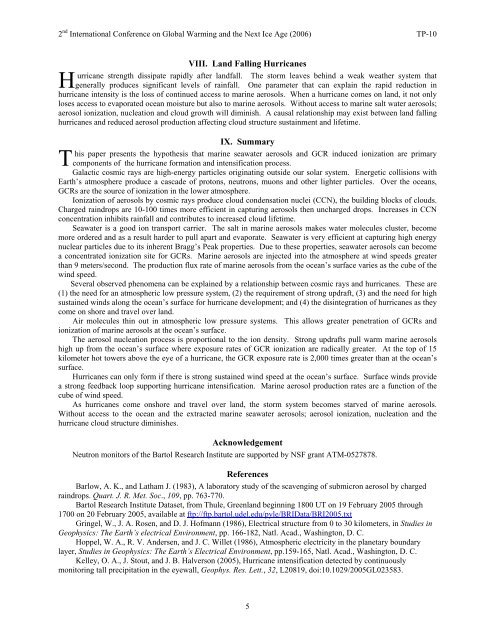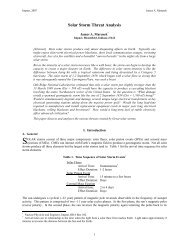THE COSMIC CLOCK, THE CYCLE OF TERRESTRIAL ... - Impact
THE COSMIC CLOCK, THE CYCLE OF TERRESTRIAL ... - Impact
THE COSMIC CLOCK, THE CYCLE OF TERRESTRIAL ... - Impact
Create successful ePaper yourself
Turn your PDF publications into a flip-book with our unique Google optimized e-Paper software.
2 nd International Conference on Global Warming and the Next Ice Age (2006) TP-10<br />
H<br />
VIII. Land Falling Hurricanes<br />
urricane strength dissipate rapidly after landfall. The storm leaves behind a weak weather system that<br />
generally produces significant levels of rainfall. One parameter that can explain the rapid reduction in<br />
hurricane intensity is the loss of continued access to marine aerosols. When a hurricane comes on land, it not only<br />
loses access to evaporated ocean moisture but also to marine aerosols. Without access to marine salt water aerosols;<br />
aerosol ionization, nucleation and cloud growth will diminish. A causal relationship may exist between land falling<br />
hurricanes and reduced aerosol production affecting cloud structure sustainment and lifetime.<br />
T<br />
IX. Summary<br />
his paper presents the hypothesis that marine seawater aerosols and GCR induced ionization are primary<br />
components of the hurricane formation and intensification process.<br />
Galactic cosmic rays are high-energy particles originating outside our solar system. Energetic collisions with<br />
Earth’s atmosphere produce a cascade of protons, neutrons, muons and other lighter particles. Over the oceans,<br />
GCRs are the source of ionization in the lower atmosphere.<br />
Ionization of aerosols by cosmic rays produce cloud condensation nuclei (CCN), the building blocks of clouds.<br />
Charged raindrops are 10-100 times more efficient in capturing aerosols then uncharged drops. Increases in CCN<br />
concentration inhibits rainfall and contributes to increased cloud lifetime.<br />
Seawater is a good ion transport carrier. The salt in marine aerosols makes water molecules cluster, become<br />
more ordered and as a result harder to pull apart and evaporate. Seawater is very efficient at capturing high energy<br />
nuclear particles due to its inherent Bragg’s Peak properties. Due to these properties, seawater aerosols can become<br />
a concentrated ionization site for GCRs. Marine aerosols are injected into the atmosphere at wind speeds greater<br />
than 9 meters/second. The production flux rate of marine aerosols from the ocean’s surface varies as the cube of the<br />
wind speed.<br />
Several observed phenomena can be explained by a relationship between cosmic rays and hurricanes. These are<br />
(1) the need for an atmospheric low pressure system, (2) the requirement of strong updraft, (3) and the need for high<br />
sustained winds along the ocean’s surface for hurricane development; and (4) the disintegration of hurricanes as they<br />
come on shore and travel over land.<br />
Air molecules thin out in atmospheric low pressure systems. This allows greater penetration of GCRs and<br />
ionization of marine aerosols at the ocean’s surface.<br />
The aerosol nucleation process is proportional to the ion density. Strong updrafts pull warm marine aerosols<br />
high up from the ocean’s surface where exposure rates of GCR ionization are radically greater. At the top of 15<br />
kilometer hot towers above the eye of a hurricane, the GCR exposure rate is 2,000 times greater than at the ocean’s<br />
surface.<br />
Hurricanes can only form if there is strong sustained wind speed at the ocean’s surface. Surface winds provide<br />
a strong feedback loop supporting hurricane intensification. Marine aerosol production rates are a function of the<br />
cube of wind speed.<br />
As hurricanes come onshore and travel over land, the storm system becomes starved of marine aerosols.<br />
Without access to the ocean and the extracted marine seawater aerosols; aerosol ionization, nucleation and the<br />
hurricane cloud structure diminishes.<br />
Acknowledgement<br />
Neutron monitors of the Bartol Research Institute are supported by NSF grant ATM-0527878.<br />
References<br />
Barlow, A. K., and Latham J. (1983), A laboratory study of the scavenging of submicron aerosol by charged<br />
raindrops. Quart. J. R. Met. Soc., 109, pp. 763-770.<br />
Bartol Research Institute Dataset, from Thule, Greenland beginning 1800 UT on 19 February 2005 through<br />
1700 on 20 February 2005, available at ftp://ftp.bartol.udel.edu/pyle/BRIData/BRI2005.txt<br />
Gringel, W., J. A. Rosen, and D. J. Hofmann (1986), Electrical structure from 0 to 30 kilometers, in Studies in<br />
Geophysics: The Earth’s electrical Environment, pp. 166-182, Natl. Acad., Washington, D. C.<br />
Hoppel, W. A., R. V. Andersen, and J. C. Willet (1986), Atmospheric electricity in the planetary boundary<br />
layer, Studies in Geophysics: The Earth’s Electrical Environment, pp.159-165, Natl. Acad., Washington, D. C.<br />
Kelley, O. A., J. Stout, and J. B. Halverson (2005), Hurricane intensification detected by continuously<br />
monitoring tall precipitation in the eyewall, Geophys. Res. Lett., 32, L20819, doi:10.1029/2005GL023583.<br />
5




